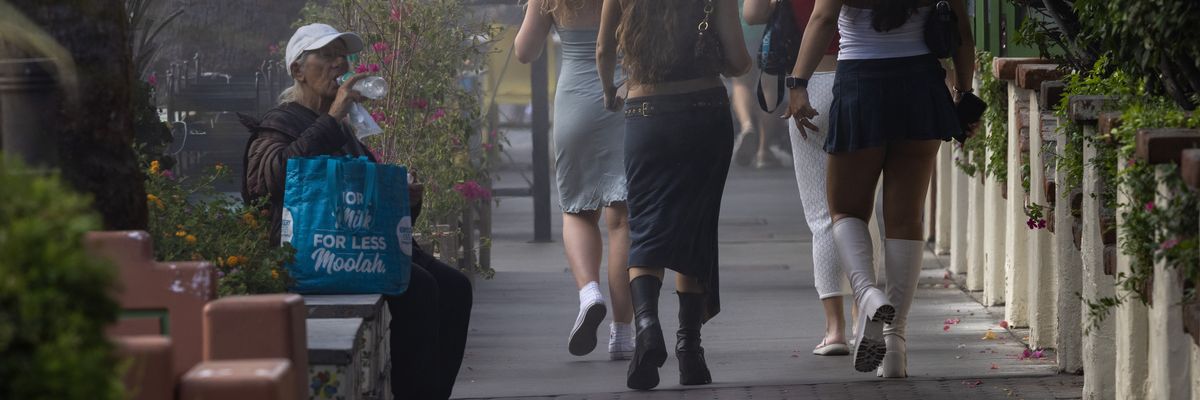In discussions about climate change, we often gravitate towards those affected by devastating wildfires, catastrophic hurricanes, and vanishing coastlines. Rarely do we zoom in on the intimate, day-to-day ways it reshapes the individual lives of everyday people. As a caregiver for my elderly parents, I've experienced firsthand how climate change impacts the aging population, a narrative told less frequently but just as critical in weighing the costs of our inaction on climate.
In the blink of an eye, many of us went from sons and daughters to climate responders for our parents. During Michigan's infamous "Snowmageddon" in 2015, for example, my father, who was relearning to walk after a health scare, constantly fell into steep snow drifts. This meant he had to wear wet pants in the freezing cold and through doctor appointments, risking hypothermia. That same winter, my mom had to mail canned foods to my great aunt, who was trapped in her Grand Rapids home without groceries because relatives and even neighbors could not safely reach her due to the massive amounts of snowfall. These life-threatening situations, no different from what other families experience, were induced by our changing climate.
Living with these challenges means perpetual fear. I'm terrified of my mother slipping on black ice and breaking her hip, of my blind father's inability to detect and avoid ice patches, especially as snow-muffled sounds interfere with outdoor navigation. When a severe ice storm led to a power outage, ensuring my parents' safety in their unheated home was a logistical nightmare, from planning how to navigate slippery sidewalks and driveways in the middle of the night, to undriveable road conditions without traffic lights, to replacing the lost food. The situation was further complicated by the fact that their landline is tied to the internet, hampering their inability to make calls in a power outage. My own cell phone lost service because the cell tower was out.
Creating a rain garden to manage increased rainfall and flooding is a daunting task for someone with a bad back or severe allergies.
But the impacts of climate change extend beyond newly increased winter extremes. For my mother, who relies on walks with friends for mental and physical wellness, unpredictable weather patterns like poor air quality or extreme heat have imprisoned her indoors more frequently. Our lives now revolve around a complex choreography of scheduling doctors' appointments between forecasted weather extremes and finding ways to mitigate newfound environmental hazards.
These climate shifts bring new responsibilities for family caregivers. Each decision, from managing the heightened frequency of snow removal services to ensuring safe, accessible outdoor spaces, is a balancing act between health, safety, and financial constraints. Creating a rain garden to manage increased rainfall and flooding is a daunting task for someone with a bad back or severe allergies.
Climate change has subtly altered our natural environment, bringing unexpected challenges. Overgrown yards in our neighborhood release rampant pollen, aggravating my father's allergies. His thin and tearing sclera makes each sneeze a cause for anxiety. New growths of poison ivy near our porch, previously unheard of, threaten his sensitive skin.
Beyond the immediate environmental hazards, there are indirect, equally unsettling effects. The nutritional value of food is changing, with implications for elderly health. Delivery of essential prescriptions, like those from the VA, gets complicated with intense rainfall, heat, cold, and snow, risking delays or damage.
Often, people ask why family caregivers don't opt for institutional care. The answer is twofold. Culturally, my upbringing emphasizes family-based care. I believe that our elders should be surrounded by love and familiarity, and that caring for them is an honor. This perspective is reinforced by broader arguments for deinstitutionalization, which champions dignity and independence for the elderly and disabled in their communities.
Not that climate challenges are exclusive to home settings. Costly facilities also face power outages, complex evacuation challenges, and disrupted staff and supply chains due to extreme weather. Such instances further unveil broader systemic issues, pointing to the need to better support caregivers in the face of climate change.
As our population ages, our laws and regulations must acknowledge and address the unique hurdles of home-based elder care. We need infrastructure adaptations and proactive policymaking that accommodate a range of familial choices and take into account the changing environmental realities.
Organizations like Area Agencies on Aging and the Veterans Administration already offer comprehensive, hands-on training programs for family caregivers. To help caregivers effectively manage extreme weather risks, their curricula should be updated to provide at least 20 hours of focused instruction on how climate change affects vulnerable populations. Topics covered should include how to create detailed emergency plans and how to proactively prepare for environmental changes.
Beyond practical skills, these programs should also address the socioemotional impacts of climate emergencies on the elderly and disabled. Events like hurricanes, wildfires, heat waves, and drought can heighten feelings of vulnerability and anxiety, adversely affecting mental health. Caregivers, who often bear the brunt of these disruptions, risk burnout without adequate support. Training should therefore include emotional first aid strategies to help them maintain a reassuring presence, discuss fears and concerns, and foster resilience and security.
Last but never least, caregiver self-care is vital. Training needs to cover how to recognize burnout signs, stress management techniques, and the importance of a supportive community. A holistic approach to care safeguards the mental and emotional well-being of both caregiver and care recipient. This stability is crucial for sustainable caregiving in the face of climate change's challenges.
Climate change is not a distant threat for family caregivers; it's a current crisis reshaping the lives of millions. The experiences of caregivers like myself highlight the overlooked nuances in our response to this global challenge. It's imperative that adaptation strategies and emergency response plans include the unique needs of the elderly. Only then can we claim to be truly addressing the breadth and depth of climate change's impact on our society.

